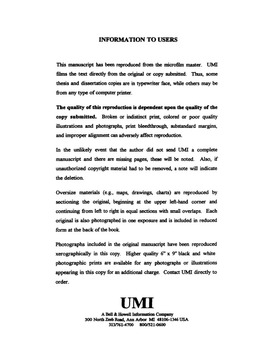| dc.contributor.advisor | O'Hair, H. Dan, | en_US |
| dc.contributor.author | Ledlow, Gerald Ronald. | en_US |
| dc.date.accessioned | 2013-08-16T12:30:28Z | |
| dc.date.available | 2013-08-16T12:30:28Z | |
| dc.date.issued | 1999 | en_US |
| dc.identifier.uri | https://hdl.handle.net/11244/5778 | |
| dc.description.abstract | The purpose of this study was to examine characteristics of communication in a managed care context. Nurse call centers were the focus of the study and several objectives were pursued. The study sought to determine the level of communication quality between patients (customers) and nurses in the call center. Secondly, the study was interested in examining the quality of communication between physicians and non-physician providers and the nurse call center from the provider's perspective. Measuring the timeliness, accuracy, usefulness, and quantity of communication, by survey instrument, provides a comprehensive picture of communication quality. As it was hypothesized, patients differ, these measures served as the independent variables for the study, in socioeconomic status, needs, experience, age, and various other factors, and their assessment and perception of nurse call center communication quality should differ. Likewise, providers who differ in training, special, and experience, should have different perceptions and expectations of communication. Also, location of the beneficiary and provider of care in relation to the nurse call center should have an impact on perceptions of communication quality. | en_US |
| dc.description.abstract | Providers' communication quality needs were not met in this study. All dimensions of communication quality showed significant differences for provider perceptions of actual communication when compared to the provider ideal quality. Older providers and those who were distant to the nurse call center had higher timeliness dimension scores. Providers who were local, had internal medicine or ob/gyn specialties, and were 40 to 50 years old had lower quantity (excessive flow of information) scores. Dimensions of accuracy and usefulness revealed no significant predictors. | en_US |
| dc.description.abstract | Female beneficiaries scored higher in the timeliness, accuracy, and usefulness communication quality dimensions. Beneficiaries with high health self-efficacy scored higher for the timeliness dimension than low self-efficacy subjects, although females with low health self-efficacy scored higher than males with high or low health self-efficacy. For the accuracy dimension, civilians and local beneficiaries scored higher than other groups. The low socio-economic group, civilian beneficiaries, and age groups 19 to 25 and 36 to 40 scored higher in the usefulness dimension than other groups. The quality communication dimension revealed no significant findings. Implications of the results and limitations of the study were discussed. | en_US |
| dc.format.extent | xii, 175 leaves : | en_US |
| dc.subject | Nurse and physician. | en_US |
| dc.subject | Business Administration, Management. | en_US |
| dc.subject | Health Sciences, Nursing. | en_US |
| dc.subject | Nurse and patient. | en_US |
| dc.subject | Communication in medicine. | en_US |
| dc.subject | Health Sciences, Health Care Management. | en_US |
| dc.title | Healthcare demand management system communication among the primary care provider, the beneficiary, and the nurse call center. | en_US |
| dc.type | Thesis | en_US |
| dc.thesis.degree | Ph.D. | en_US |
| dc.thesis.degreeDiscipline | Department of Communication | en_US |
| dc.note | Major Professor: H. Dan O'Hair. | en_US |
| dc.note | Source: Dissertation Abstracts International, Volume: 60-04, Section: B, page: 1512. | en_US |
| ou.identifier | (UMI)AAI9925591 | en_US |
| ou.group | College of Arts and Sciences::Department of Communication | |
